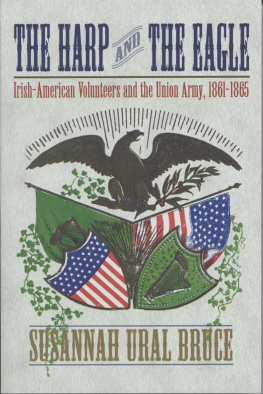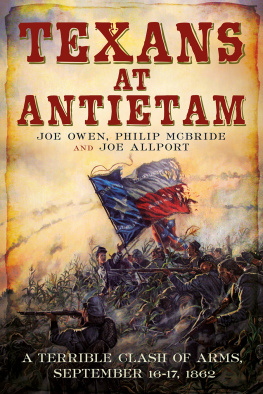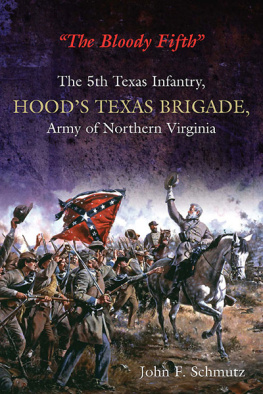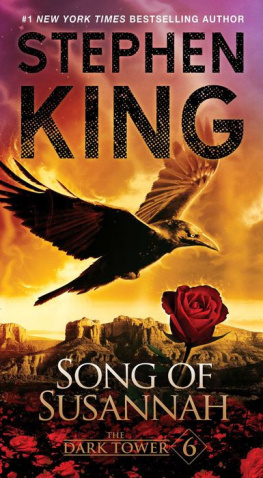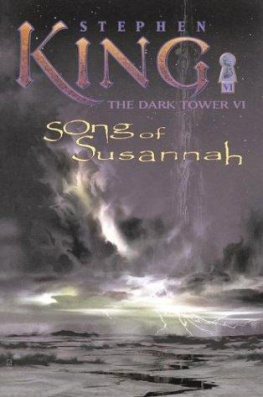Published by Louisiana State University Press
Copyright 2017 by Louisiana State University Press
All rights reserved
Manufactured in the United States of America
First printing
Designer: Michelle A. Neustrom
Typefaces: Sentinel, text; Centrifuge, display
Printer and binder: Sheridan Books, Inc.
Maps created by George Skoch
Library of Congress Cataloging-in-Publication Data
Names: Ural, Susannah J., author.
Title: Hoods Texas Brigade : the soldiers and families of the Confederacys most celebrated unit / Susannah J. Ural.
Other titles: Conflicting worlds.
Description: Baton Rouge : Louisiana State University Press, [2017] | Series: Conflicting worlds : new dimensions of the American Civil War | Includes bibliographical references and index.
Identifiers: LCCN 2017019254| ISBN 978-0-8071-6759-5 (cloth : alk. paper) | ISBN 978-0-8071-6760-1 (pdf) | ISBN 978-0-8071-6761-8 (epub)
Subjects: LCSH: Confederate States of America. Army. Texas Brigade. | TexasHistoryCivil War, 18611865. | United StatesHistoryCivil War, 18611865.
Classification: LCC E580.4.T4 U73 2017 | DDC 973.7/464dc23
LC record available at https://lccn.loc.gov/2017019254
The paper in this book meets the guidelines for permanence and durability of the Committee on Production Guidelines for Book Longevity of the Council on Library Resources.

CONTENTS
1
TO ARMS IN TEXAS
Mobilizing the First Thousand Texans for Virginia
2
THE RUSH TO VIRGINIA
The Organization of the Fourth and Fifth Texas Infantry
3
RECRUITS ON THE DRILL FIELD
Becoming Citizen-Soldiers
4
THE POTOMAC BLOCKADE
The Texas Brigades First Assignment
5
SEEING THE ELEPHANT
Turning Scouts into Soldiers
6
SLIPPING THE BRIDLE
The Battles of Second Manassas and Antietam
7
THE COST OF REPUTATION
Emancipation, Suffolk, and Gettysburg
8
A LACK OF LEADERSHIP
The Battle of Chickamauga and the Hard Winter of 1863
9
REUNION WITH LEE
From the Wilderness through Petersburg
10
DETERMINATION AND DEFEAT
The Final Defense of Richmond and Surrender at Appomattox
11
WAGING PEACE
Texas Brigade Veterans and Families in Reconstruction and Beyond
ACKNOWLEDGMENTS
I started researching and writing about Hoods Texans in 2004, the year my son was born. Hell be in eighth grade by the time these words appear in print. In my defense, I published three other books in the meantime, but I always returned to this project, fascinated by the men and their families and determined to help readers understand the significance of Hoods Texas Brigade in a new way. The first draft of this manuscript felt flat. I scrapped much of it because I offered few new insights and failed to capture the complexities of my subjects. My second draft benefited from a rich narrative but still failed to explain what made this unit so successful on the battlefield and so loyal to each other and their cause. Like Goldilocks, my third attempt at the manuscript was just right, thanks in no small part to the Dale Center for the Study of War & Society at the University of Southern Mississippi awarding me the Blount Professorship in Military History in 2013. This provided me with the resources and time to rethink, reshape, and rewrite this book. It proved invaluable to this project, and Im thankful to Maj. Gen. Buford Buff Blount and his wife, Anita, for establishing the professorship to support Southern Miss historians working in the field of war and society.
I am indebted to a host of archivists, but several of you went above and beyond to help me track down materials: Louise Arnold-Friend, the late Art Bergeron, Jack Bobinger, John Coski, Peggy Fox Michaels, Julie Holcomb, David Keough, Barbara Kievit-Mason, Judy Pate, Richard J. Sommers, Cheryl Spencer, and John Versiluis. Thanks, too, to the National Park Service historians who helped me work in their collections or hiked battlefields with me (or both): Ted Alexander, Scott Hartwig, John Hennessy, Bobby Krick, Jim Ogden, Frank OReilly, and Don Pfanz. Other historians and researchers shared their Texas Brigade research, walked positions with me, and debated key issues for this book: Robert Alton, Keith Bohannon, Pete Carmichael, Tom Clemens, Andie Custer, Rich DiNardo (who, along with his wife, Rita, hosted me during several research trips to northern Virginia), Rick Eiserman, John Favors, Don Frasier, Chuck Grear, Rick McCaslin, Jeff Prushankin, Carol Reardon, Ron Smith, Mark Snell, David Ward, Beth White, and Alfred Young. I also want to thank Rand Dotson, Lee Sioles, Neal Novak, and Kate Barton at LSU Press, who have been a pleasure to work with, as well as series editor Mike Parrish, who has the patience of Job. Thanks, too, to copy editor Susan Murray for her superb work and confidentiality policy on authors grammatical weaknesses (that is confidential, right?), and to the talented George Skoch, who designed the maps for this book.
A group of friends and scholars critiqued this manuscript in its third and final phase. Rick Eiserman, Gary Gallagher, Lesley Gordon, Will Greene, and Mike Parrish read it in its entirety and offered key corrections, suggestions, and support. Thank you all. My thanks also go to Tom Clemens, Scott Hartwig, John Hennessy, Bobby Krick, Wayne Motts, Dave Powell, Carol Reardon, Andy Slap, Frank Towers, and Jon Wells who advised me on sections tied to their areas of expertise. If errors remain after all this help, they are, clearly, my own.
My colleagues at Sam Houston State University in Huntsville, Texas, where I began this project, were essential for the success of the first phase of this work: the late Terry Bilhartz, Caroline Castillo Crimm, Kenneth E. Hendrickson III, Nancy Sears Leavell, and Charlann Morris. My University of Southern Mississippi colleagues were key to the final half of this project, offering invaluable advice and encouragement along the way. Special thanks go to Allison Abra, Shelia Garris McArn, Heather Stur, Cindy Warren, Andy Wiest, and Kyle Zelner. Dr. J. T. Johnson, Director of the Center for Research Support at Southern Miss, was invaluable as I created the concept for my Texas Brigade sample and then processed and interpreted that data.
Several of my current and former graduate students helped with the statistical information for this book. Allan Branstiter did yeomans work entering data for the large Texas Brigade sample, and Stephanie Seal Walters applied her digital history skills to help me clean and interpret that information. My thanks go to Samantha Taylor and Tracy Barnett for their help with images for this book, and, very early on, to a former student and now Texas history teacher, Leslie Hegman Sproat. Leslie traveled with me as we traced Hoods Texans from battlefield to battlefield, allowing me to work in archives by day, and then she, my son, Robby, and I toured key Texas Brigade positions in the evening.






